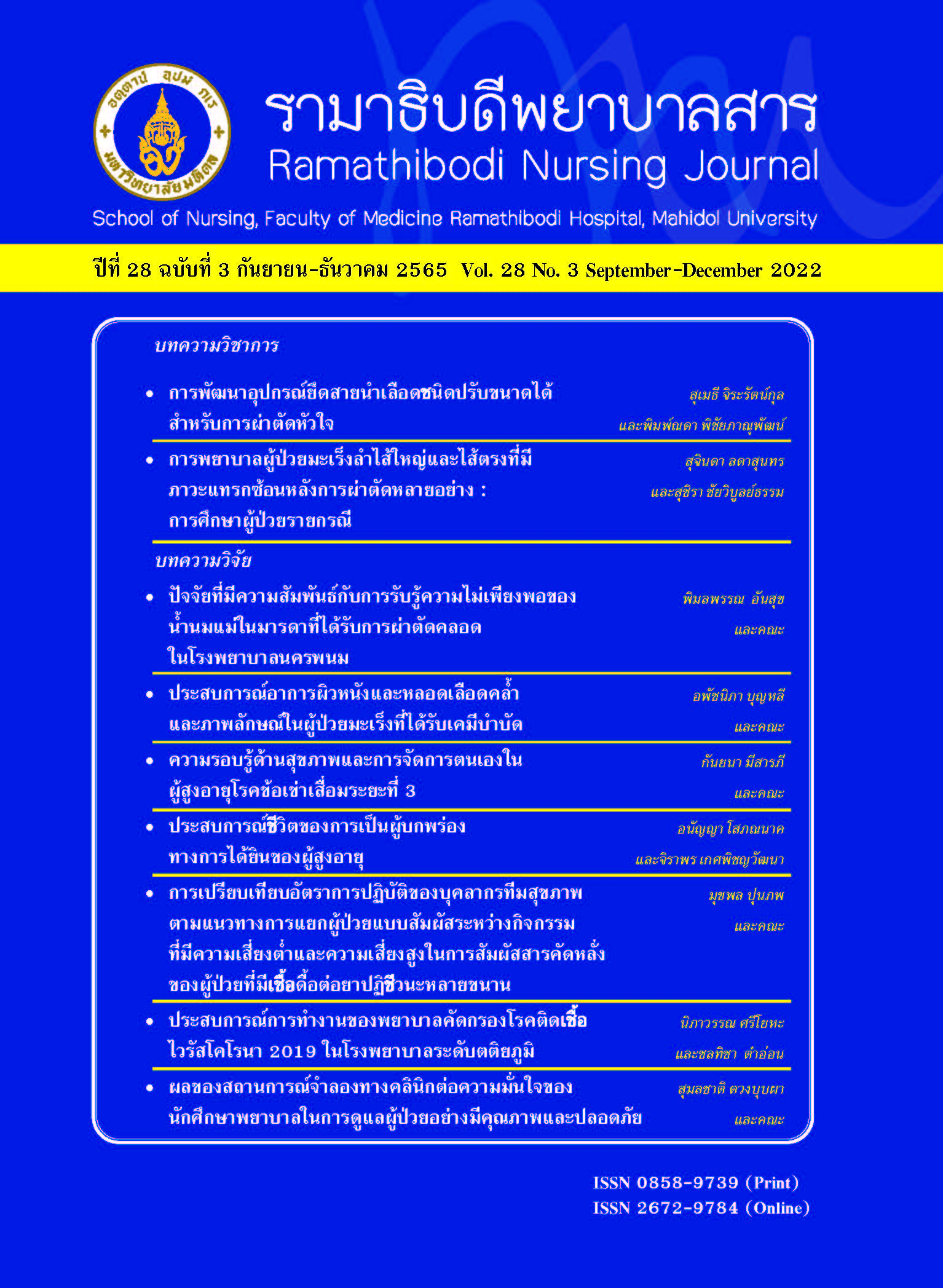Nursing Management of Patients with Colorectal Cancer and Multipale Complications After Surgery : A Case Study
Main Article Content
Abstract
Abstract
Colorectal cancer is a disease that tends to increase significantly. The treatment is colon resection, which is a risk for multiple complications. The patient in this case study was diagnosed with stage 3 colorectal cancer with multiple myomas and underwent colorectal surgery with a total hysterectomy. The case encountered multiple complications,including anastomosis leakage, after the surgery. She underwent an ostomy creation for fecal diversion and was retained with a Foley catheter for urinary drainage. These procedures led to changes in body image and anxiety about continuity care at home. This article aimed to analyze health problems compared to the treatment guidelines for a colorectal patient with postoperative complications. The advanced practice nurse played the case manager role, using evidence-based care and Orem’s nursing theory to enhance self-care capabilities and promote safety and well-being after the surgery.
Keywords: Colorectal cancer, Anastomosis leakage, Self-care, Colostomy
Article Details

This work is licensed under a Creative Commons Attribution-NonCommercial-NoDerivatives 4.0 International License.
บทความ ข้อมูล เนื้อหา รูปภาพ ฯลฯ ที่ได้รับการตีพิมพ์ในรามาธิบดีพยาบาลสาร ถือเป็นลิขสิทธิ์ของวารสาร หากบุคคลหรือหน่วยงานใดต้องการนำทั้งหมดหรือส่วนหนึ่งส่วนใดไปเผยแพร่หรือเพื่อกระทำการใด ใด จะต้องได้รับอนุญาตเป็นลายลักษณ์อักษรจากรามาธิบดีพยาบาลสารก่อนเท่านั้น
References
American Cancer Society. Colorectal cancer risk factors[Internet]. Atlanta, GA: ACS; 2018 [cited 2020 Jan 27]. Available from: https://www.cancer.org/cancer/colon-rectal-cancer/causes-risks-prevention/risk-factors.html
World Health Organization & International Agency Research on Cancer. Global cancer observational [Internet]. Geneva; WHO, 2020, [cited 2020 Jan 27].Available from: https://gco.iarc.fr/today/onlineanalysis-multi-bars?v=2018&mode=cancer
National Cancer Institute. Hospital-level cancer registry 2018. Bangkok: Pornsubprint; 2019. (in Thai)
National Cancer Institute. Screening guidelines. Diagnose and treat colon and rectal cancer. National Cancer Institute,Department of Medicine, Ministry of Public Health.Bangkok: Kosit Printing; 2015. (in Thai)
Benson AB, Venook AP, Al-Hawary MM, Arain MA,Chen YJ, Ciombor KK, et al. NCCN Guidelines Insights:Rectal Cancer, Version 6.2020. J Natl Compr Canc Netw.2020;18(7):806-15.
Pitakteerabundit T, Laohawiriyakamol S. Management of colorectal anastomosis complication, collective review Department of Surgery, Faculty of Medicine Songkhla Nakarin University; 2016. (in Thai)
Yun JA, Cho YB, Park YA, Huh JW, Yun SH, Kim HC,et al. Clinical manifestations and risk factors of anastomotic leakage after low anterior resection for rectal cancer. ANZ J Surg. 2017;87(11):908-14.
Szpilewska K, Juzwiszyn J, Bolanowska Z, Bolanowska Z, Milan M, Chabowski M, et al. Acceptance of disease and the quality of life in patients with enteric stoma. Pol Przegl Chir. 2018;90(1):13-7.
Orem D. Nursing: Concept of practice. (3rd ed.) NewYork: McGraw-Hill; 1985.
Hanucharurnkul S. Self-care: nursing science and arts.Bangkok: VJ Printing; 2001. (in Thai)
Merriam S, Mullins L. Havighurst’ s adult delopment tasks Act Adapt Aging. 1981;1(3):9-22.
Sananpanichkul P. Myoma uteri. Clinic Med Education Center, Phra Pok Klao Hospital 2012; 29: 312-37. (inThai)
McDermott FD, Heeney A, Kelly ME, Steele RJ, Carlson GL, Winter DC. Systematic review of preoperative,intraoperative and postoperative risk factors for colorectal anastomotic leaks. Br J Surg. 2015;102(5):462-79.doi:10.1002/bjs.9697.
McDermott F, Arora S, Smith J, Steele R, Carlson G,Winter D, et al. Prevention, Diagnosis and management of colorectal anastomosis leakage [Internet]. 2016. [cited2021 Jan 22]. Available from: https://www.researchgate.net/publication/297250602
Thomas MS, Margolin DA. Management of colorectal anastomotic leak. Clin Colon Rectal Surg.2016;29(2):138-44. doi:10.1055/s-0036- 1580630
Chu H, Zhao L, Wang M, Liu Y, Gui T, Zhang J.Sulbactam-based therapy for Acinetobacter baumannii infection: a systematic review and meta-analysis. Braz J Infect Dis. 2013;17(4):389-94.
Sartelli M, Chichom-Mefire A, Labricciosa FM,Hardcastle T, Abu-Zidan FM, Adesunkanmi AK, et al.The management of intra-abdominal infections from a global perspective: 2017 WSES guidelines for management of intra-abdominal infections. World J Emerg Surg.2017;12(1):1-34.
Khwaja A. KDIGO clinical practice guidelines for acute kidney injury. Nephron Clin Pract. 2012;120(4):179-84. doi:10.1159/000339789.
Srisawad N, Tangsanga K. Acute renal failure. Department of Medicine J. 2017;42:64-8. (in Thai)
Theerathongdee K, Ronnaritthiwichai C, Thongcharoen W, Pongthawornkamol K. Factors predicting quality of life in elderly patients undergoing ostomy surgery. World Cancer J. 2014;34:68–8. (in Thai)
Delacroix SE Jr, Winters JC. Voiding dysfunction after pelvic colorectal surgery. Clin Colon Rectal Surg.2010;23(2):119-127. doi:10.1055/s-0030-1254299.
Imaizumi K, Tsukada Y, Komai Y, Nomura S, Ikeda K,Nishizawa Y, et al. Prediction of urinary retention after surgery for rectal cancer using voiding efficiency in the 24h following Foley catheter removal. Int J Colorectal Dis.2019;34(8):1431-1443. doi:10.1007/s00384-
-03333-y.
Spitzer RL, Kroenke K, Williams JBW, Löwe B. A brief measure for assessing generalized anxiety disorder: the GAD-7. Arch Intern Med. 2006;166(10):1092-7.
WOCN Society Clinical Guideline: Management of the adult patient with a fecal or urinary ostomy-an executive summary. J Wound Ostomy Continence Nurs. 2018;45(1):50-8.
Seo HW. Effects of the frequency of ostomy management reinforcement education on self-care knowledge, selfefficacy,
and ability of stoma appliance change among Korean hospitalised ostomates. Int Wound J. 2019;16 Suppl 1(Suppl 1):21-8.


